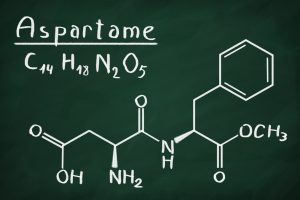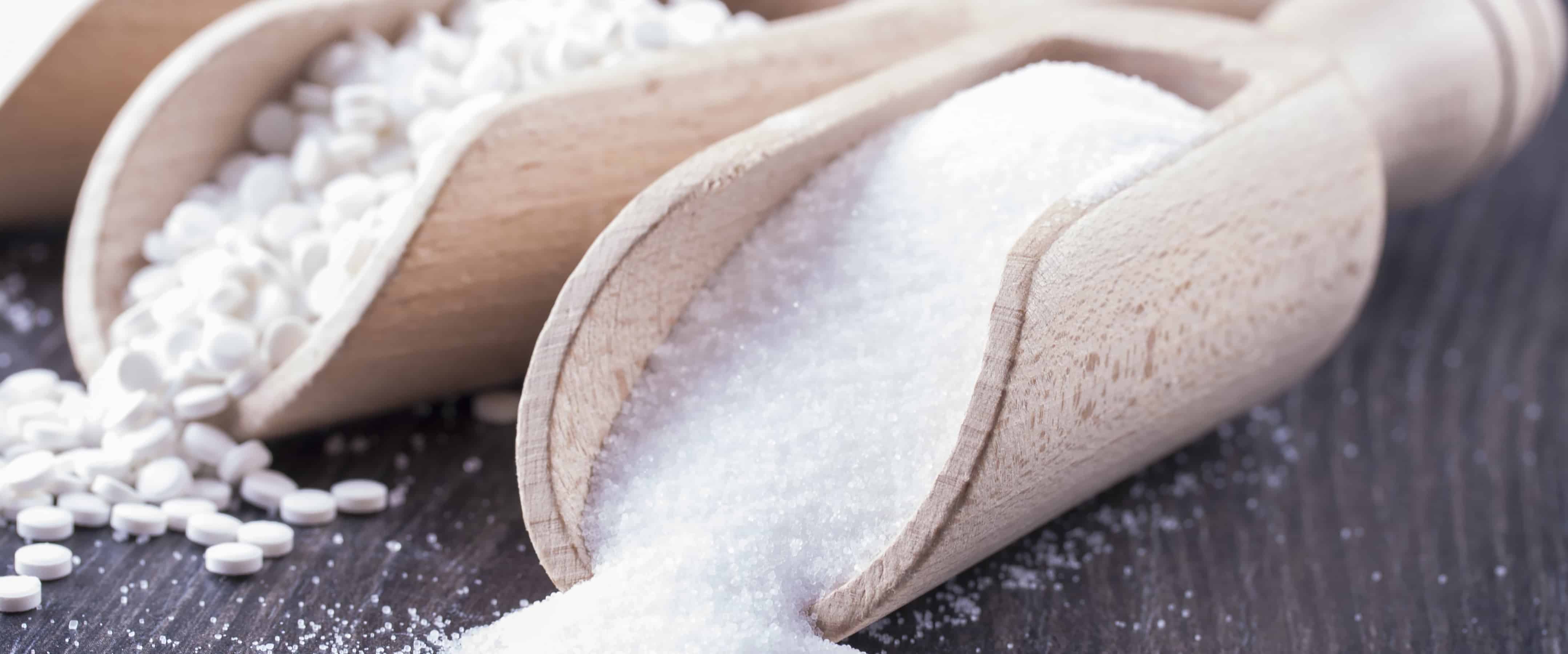The history of aspartame dates back to 1965 when the low-calorie sweetener was accidentally discovered by chemist James Schlatter. After the evaluation of data from required studies, the U.S. Food and Drug Administration approved aspartame for use in certain foods in 1981, soft drinks in 1983, and authorized aspartame as a general-purpose sweetener for foods and beverages in 1996. The European Union approved aspartame in 1994 as a food additive. It is currently approved for use in more than 100 countries.
Aspartame has a very interesting history with lots of twists and turns since its approval more than 30 years ago. Check out the timeline below to learn more.
What is Aspartame?

Aspartame is a low-calorie sweetener that is much sweeter than sugar. Less aspartame is needed to provide a sweet taste so (in the packet or bag) it is commonly mixed with other ingredients to make it more convenient for consumers to substitute aspartame for a similar amount of sugar.
While table sugar is made of the two carbohydrates glucose and fructose, aspartame is composed of two amino acids, aspartic acid and phenylalanine, linked together. When the body breaks down aspartame the two amino acids are separated and a small amount of methanol is formed. These same compounds are also found in much larger amounts infrequently eaten foods including meat, milk, fruits, and vegetables. So, the amount you get from aspartame is minuscule compared with what you consume from other sources. Whether they come from food or aspartame, the body uses the amino acids and methanol in exactly the same way and is unable to distinguish the original source.
With around-the-clock media coverage, the Internet and social media all competing for viewers, listeners, readers and clickers, sensational headlines abound. Personal testimonials and misinterpreted studies about food and nutrition can create confusion and fear. Aspartame is no exception with unsubstantiated negative claims proliferating in the media and on the web contrary to substantial evidence supporting its safety and role in a healthful eating plan. Rather than believing every scary headline you see, consider the source, read other viewpoints and consult a reliable expert, like a registered dietitian or reputable sites like the Academy of Nutrition and Dietetics, American Heart Association, American Cancer Society, American Diabetes Association, U.S. Department of Agriculture and Food and Drug Administration.
TImelineBrief History of Aspartame
1965
Aspartame is discovered.
1981
The U.S. Food and Drug Administration (FDA) approves aspartame for use in dry goods.
1983
The U.S. FDA increases the Acceptable Daily Intake (ADI) for aspartame to 50 mg per kg of body weight per day. That means a 150 lb adult can safely consume 20 12 oz diet sodas daily over a lifetime.
1983
The U.S. FDA expands their approval to include carbonated soft drinks.
1984
The U.S. Centers for Disease Control and Prevention (CDC) evaluates reported adverse events from aspartame use including claims ranging from headaches, insomnia, dizziness and changes in mood to nausea, diarrhea and other gastrointestinal issues. The CDC determines, “Despite great variety overall, the majority of frequently reported symptoms were mild and are symptoms that are common in the general populace.”
1999
The Multiple Sclerosis Foundation invalidates claims that aspartame causes multiple sclerosis (MS), concluding there is no association between aspartame and MS.
1999
The U.S. FDA and Brazil’s regulatory agency, Agencia Saude, discredit a wide range of web-based allegations that aspartame negatively affects health, determining that there is no scientific support for these allegations and the reported issues are anecdotal in nature.
2000
The United Kingdom’s Food Standards Agency also reviews Internet allegations related to aspartame and confirms findings from the US and Brazil that they are anecdotal and not supported by science.
2002
“Aspartame: A Safety Review” is published in Regulatory Toxicology and Pharmacology and concludes, “After 30 plus years of rigorous scientific research, it is time to put questions of aspartame safety to rest. It is difficult to identify any dietary constituent that has been more thoroughly evaluated than aspartame.”
2006
Using methods do not follow standard, acceptable protocol and scientific practice for evaluating cancer, the Ramazzini Institute in Italy suggests that aspartame causes leukemia and lymphoma in rats.
2006
The European Food Safety Authority (EFSA) denounces the findings of the Ramazzini Institute and notes there is no reason to recommend any dietary change in regard to aspartame.
2007
The U.S. FDA reconfirms aspartame’s safety and also denounces findings reported by the Ramazzini Institute, noting significant shortcomings in the design, conduct, reporting, and interpretation of this study, compromising the results especially due to uncontrolled variables, such as the presence of infection in the test animals.
2007
An evaluation published in Critical Reviews in Toxicology notes, “Aspartame does not increase hunger in those who use it; to the contrary, studies indicate it might be an effective tool as part of an overall weight management program. Aspartame is a well characterized, thoroughly studied, high intensity sweetener that has a long history of safe use in the food supply and can help reduce the caloric content of a wide variety of foods.”
2009
EFSA’s Panel on Food Additives and Nutrient Sources Added to Food (ANS) reconfirms the safety of aspartame and states, “Overall, the Panel concluded on the basis of all the evidence currently available including the last published ERF [European Ramazzini Foundation] study that there is no indication of any genotoxic or carcinogenic potential of aspartame…” noting variables in its research, including pre-existing diseases in test animals. The Panel reiterated that the study design is not reflective of currently accepted toxicological methodologies.
2013
EFSA’s ANS Panel reviews aspartame once again and again reconfirms its safety. Dr. Alicja Mortensen, chair of the Panel, stated, “This opinion represents one of the most comprehensive risk assessments of aspartame ever undertaken.”
Tips & Recipes
Learning to live a healthier lifestyle is easy when you change one small thing at a time. Find recipes and tips to start the change today!

Should You Avoid Aspartame?
More than 100 countries have all affirmed aspartame’s safety. Check out the position of several well-known and respected organizations.
Learn moreWhat are the Benefits?
Substituting aspartame for sugar or other calorie-containing sweeteners allows people to indulge sweet cravings while consuming fewer calories.
Learn more



